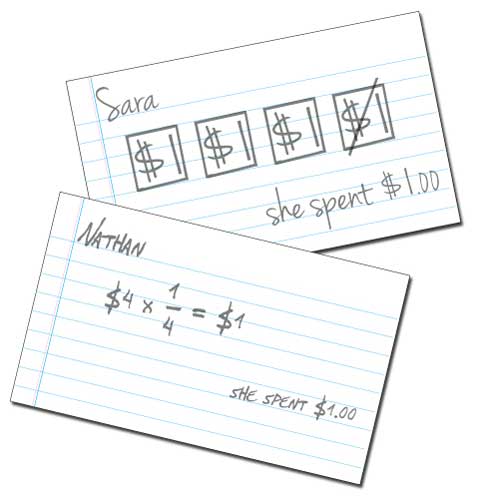What is differentiated instruction?
Page 2: General Principles

Differentiated instruction is not a one-size-fits-all approach, but instead should be shaped to meet the needs of students. This does not mean that teachers individually tailor instruction. Rather, they differentiate instruction for groups of students. What makes this challenging for teachers is that students’ needs vary:
- Across content areas (e.g., some students excel with math but struggle with reading)
- Within content areas (e.g., some students excel at addition but struggle with fractions)
- Across the school year (e.g., at the beginning of the year, some students struggle with reading but improve greatly due to effective instruction)
Because students’ needs change frequently, teachers should be familiar with two general principles or strategies of differentiated instruction: ongoing assessment and flexible grouping.
Ongoing Assessment
 Rather than assessing students only at the end of a unit, teachers can use assessments before, during, and after teaching a unit to gather information critical to providing effective instruction. By frequently assessing students’ knowledge and skills, teachers can use that information to develop and refine instruction to meet the students’ shifting needs. Additionally, by assessing students’ interests and learning profile, teachers can design tasks that are engaging, motivating, and accessible.
Rather than assessing students only at the end of a unit, teachers can use assessments before, during, and after teaching a unit to gather information critical to providing effective instruction. By frequently assessing students’ knowledge and skills, teachers can use that information to develop and refine instruction to meet the students’ shifting needs. Additionally, by assessing students’ interests and learning profile, teachers can design tasks that are engaging, motivating, and accessible.
learning profile
Refers to a student’s preferred method of learning new information or skills (e.g., visually, hands-on, through deductive means) and to environmental factors that influence a student’s learning (e.g., small group setting, bright lights, no distractions). In addition to these factors, a student’s profile may be influenced by gender and culture.
The Differentiated Classroom:
Responding to the Needs of All Learners (p.11)”]Assessment always has more to do with helping students grow than with cataloging their mistakes.
Teachers can assess students in a number of ways. Assessments may be formal (e.g., a unit test) or informal (e.g., an exit card [View sample]) and can often be conducted quickly. By using more than one type of assessment, teachers can get a better understanding of how to teach content or a skill for the diverse group of students in the classroom. The table below outlines the different types of assessments teachers can use when differentiating instruction.
Exit Card
An exit card is a tool for assessing student understanding of a topic or skill introduced in class. To assess the students’ understanding of the day’s lesson, teachers hand out blank index cards and ask their students to do such things as:
- Answer a specific question about the lesson
- Demonstrate a skill (adding two two-digit numbers)
- List three things they learned
- Ask a question about something they don’t understand about the topic
- Draw a picture of an item and label its parts
- Explain a concept
- Write down one thing they would like to know more about
The students write their names and responses on the cards and turn them in to the teacher. For older students, these cards are often turned in as students exit the class.
Example
Lesson: fractions
The teacher writes on the board and reads aloud: “If Sue gets $4.00 this week for her allowance and she spends one fourth of it at the store, how much did she spend? Show how you solved the problem.”

By reviewing these two exit cards, the teacher realizes that Sara needs to use a graphic representation to solve the problem, whereas Nathan is able to use a mathematical representation to solve it.
| Types of Assessments | ||
| Time Administered | Purposes | Sample Assessments |
| Before a lesson or unit (i.e., preassessment) |
|
|
|
During a lesson or unit (i.e., formative assessment)
x
formative assessment A system of providing continual feedback about preconceptions and performances to both learners and instructors; an ongoing evaluation of student learning. |
|
|
|
After a lesson or unit (i.e., summative assessment)
x
summative assessment An evaluation administered to measure student learning outcomes, typically at the end of a unit or chapter. Often used to evaluate whether a student has mastered the content or skill. |
|
|
Tip
Because assessment can provide valuable information about student learning, it should be an integral part of instruction. Teachers should avoid scheduling regular testing days (e.g., tests are routinely given on Fridays) but rather should assess students as needed.
Flexible Grouping
 To best address the learning needs of all students, teachers should use a variety of grouping methods—whole-group, small-group (usually no more than six students), or peer pairs—in addition to having students work independently. If teachers choose to use small groups or pairs, they need to consider whether the groups should be:
To best address the learning needs of all students, teachers should use a variety of grouping methods—whole-group, small-group (usually no more than six students), or peer pairs—in addition to having students work independently. If teachers choose to use small groups or pairs, they need to consider whether the groups should be:
Homogeneous—Teachers might group students with similar needs so that they can work with them to focus on specific content or skills.
Heterogeneous—Teachers might group students with different learning needs or dissimilar interests. In this way, each student brings unique strengths and knowledge to the group.
Did You Know?
Because students often find one type of grouping format particularly engaging, teachers can allow them to choose to work in groups, pairs, or independently for certain instructional activities.
The teacher should use grouping methods flexibly (i.e., flexible grouping). Instead of belonging to static groups, group membership is fluid or dynamic, changing to meet the different needs of the students. Teachers might make group assignments based on the results of ongoing assessments. Alternatively, students might choose to work in a particular group based on their interests or learning needs. Flexible grouping offers students the opportunity to work with classmates who are either similar or quite different in skill levels or interests.
 Meet Juan Carlos, a sixth-grade student. His social studies teacher uses different grouping formats and employs flexible grouping to meet the needs of her diverse learners. The scenarios below offer a glimpse at how the teacher uses flexible grouping across a week; it does not provide a complete account of each daily lesson. Notice how Juan Carlos changes groups throughout the week. This example illustrates how a student can work with a variety of classmates throughout the day or week or across a unit of study.
Meet Juan Carlos, a sixth-grade student. His social studies teacher uses different grouping formats and employs flexible grouping to meet the needs of her diverse learners. The scenarios below offer a glimpse at how the teacher uses flexible grouping across a week; it does not provide a complete account of each daily lesson. Notice how Juan Carlos changes groups throughout the week. This example illustrates how a student can work with a variety of classmates throughout the day or week or across a unit of study.
| Monday | |
 |
At the beginning of class, the teacher introduces a social studies lesson using whole-group instruction. |
 |
Using the results of a pre-assessment about the unit’s content, the teacher divides her class of twenty-seven students into five small groups, each consisting of four to six students. She groups the students according to their preexisting knowledge about the content. Because Juan Carlos has a firm grasp of the requisite knowledge, his group will be allowed to delve deeper into the content, while other groups work on tasks that will prepare them for the unit. |
| Wednesday | |
 |
Toward the end of class, the teacher has the students work in pairs. This time she pairs students heterogeneously so that one student who has a firm grasp of the content is working with a student who is struggling with it. |
| Friday | |
 |
The teacher would like for the students to begin working on a project. She allows students to work in groups based on their interests. Juan Carlos chooses to work with two other students who are interested in the same topic. |
For Your Information
Another principle of differentiated instruction is that all students should be engaged in tasks that are interesting, challenging, engaging, and focused on the key concepts and skills introduced by the lesson or unit (i.e., respectful tasks). It is often the case in traditional classrooms that a teacher’s instruction targets the average students, while struggling learners are assigned drill and practice problems and advanced students work on tangential tasks. However, in a differentiated classroom, each student, regardless of his or her skill level, should work on respectful tasks.